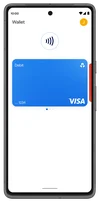What's Google Pay? Here’s how it works, and supports Australia’s digital economy
We launched Google Pay in Australia in 2016 to provide a safe, secure and convenient way for Australians to make everyday payments, and for businesses to be paid. We’ve continued to build on it through Google Wallet, which launched in 2022 and enables people to save and easily access digital versions of things they carry everyday in their physical wallets, including payment cards and boarding passes. The open architecture of the Android ecosystem has fuelled innovation in Australia and provided consumers with more choice and convenience in how they pay.
We’re sometimes asked about Google Pay and Google Wallet, and how they support Australia’s digital economy, so we wanted to answer some of the commonly asked questions here.
What’s the difference between Google Wallet and Google Pay?
Google Wallet is a digital wallet that functions just as a regular physical wallet would by allowing you to store digital versions of physical items, such as boarding passes and transit passes. Google Pay is the fast, simple way to pay using credit or debit cards saved to your Google account, whether online, or in-app and in-store with your Android device. When you see the GPay brand displayed by merchants, it means they accept Google Pay as a form of payment.
Putting these side by side, Google Wallet is a digital wallet where you can add digital versions of various items. When you add a payment card to Google Wallet, you can then use it to pay wherever Google Pay is accepted.
Ok, so is Google a bank?
We are not a bank nor do we have the intention of being a bank. Google is not involved in the flow of money when a transaction is made using our service. Payment cards added to Google Wallet function just like a physical card and are eligible for the same benefits offered by the issuing bank. No monies are ever transferred into Google Wallet and banks maintain full control over the set up and transaction approvals.
Then what’s the role of Google in the payment process?
Google enables transactions by securely transmitting payment credentials information between the paying customer’s financial institution and merchants.
Google Pay is supported by the majority of Australian banks on open, non-exclusive terms. Most of our bank and card issuer partners support more than one digital wallet for their Android customers.

Google doesn’t charge banks for access to Google Pay or Android, so why provide this service?
We want to help provide a great experience for people within the Android and Wear ecosystem, and support further innovation and activity in the digital economy.
Do you use purchase information on Google Pay to serve ads?
No, we never sell user data and purchase or transaction data to third parties, including advertisers. At Google, we take user privacy very seriously and are committed to our privacy policy. Privacy and security are at the core of the payments experiences we build at Google and we want to provide transparency and control around how information is used across Google. You can update your privacy settings from the Google Wallet app or on your computer at myactivity.google.com/product/wallet.
How are digital technology companies engaging with banks in the payments space?
At Google, we believe what’s best for the payments ecosystem are open, interoperable standards, and we are focused on making digital payments accessible to everyone. We can only speak for ourselves, as a digital technology company.
Google Pay is supported by the majority of Australian banks on open, non-exclusive terms. Most of our bank and card issuer partners support more than one digital wallet for their Android customers. For example, options for CBA customers using Android devices include the Commbank app, Google Pay and Samsung Pay.
Our ‘open’ approach has been noted by banks and third parties, including the CEO of CBA Matt Comyn: “Google, as I said, has a much more open architecture and allows multiple competing wallets, and it does not charge on the Android operating system.” Committee Transcript, 27 July 2021.
Google Wallet is offered in many countries. What makes the product unique in Australia?
Australia has long been known as a leader in adoption of mobile payments and e-commerce, and Google has invested extensively in building customised solutions for Australians. Since the launch of Google Pay in 2016, Google has expanded support for all major card schemes to include Eftpos. Aside from payments, support has been added for a variety of items ranging from transit passes such as MYKI in Melbourne, boarding passes for Virgin and Jetstar, loyalty cards from Australia’s largest loyalty programs Everyday Rewards and Flybuys to student passes for Monash University. During the pandemic, we also helped millions of Australians prove their vaccination status with our Covid Card.
An open architecture for the Android ecosystem has fuelled innovation in Australia and globally. Enabling Near Field Communication (NFC) access for third parties has resulted in significant payments innovation, and we have seen this in Australia with ‘host card emulation’ based digital wallet solutions created by device manufacturers, banks and payments companies.
What is Google’s view on payments reform?
Google has welcomed the Government’s release of the Strategic Plan for the Payments System in collaboration with industry, regulators and consumers. We support the Government’s commitment to an enhanced leadership role in the payments system, and are engaging constructively with them as they continue to develop their regulatory approach. Any regulation should be risk-based and proportionate to ensure that it does not unnecessarily or inadvertently impede innovation and competition in this area.
Payments is a complex and dynamic sector where coordination and coherence are essential in ensuring that Australian consumers and businesses get the full benefit of competition and innovation across the ecosystem.


